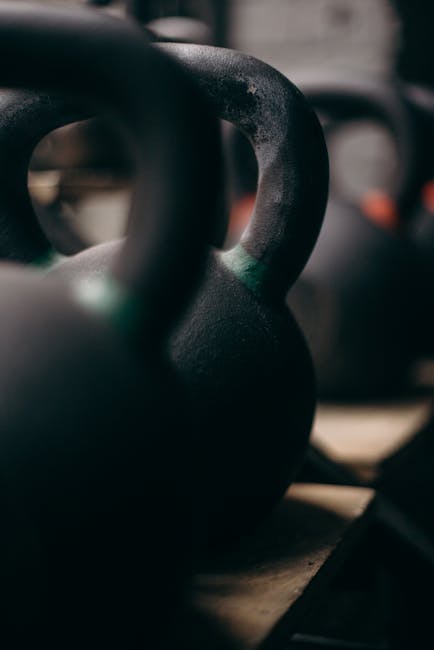Forget about benching plates or lifting heavy weights; the latest trend to hit the gym scene is taking a pause from eating. Yes, you read that right, fasting – the act of abstaining from food for a specific period, is now being touted as the magical elixir to unlock the best version of your gains. But hey, before you throw away that protein shake or bid adieu to your beloved post-workout pizza, let’s take a closer look at the topic of fasting and its impact on weight lifting in this professional, yet humorous deep-dive.
Contents
- 1 1. Introduction: The Science Behind Fasting and Weight Lifting
- 2 2. Benefits and Drawbacks of Fasting for Weight Lifters
- 3 3. Strategies for Incorporating Fasting into Your Training Regimen
- 4 4. Case Studies: Real-Life Examples of Successful Fasting and Weight Lifting
- 5 5. Expert Advice on Maximizing Your Results with Fasting and Weight Lifting
- 6 That’s a wrap!
1. Introduction: The Science Behind Fasting and Weight Lifting
Fasting and weight lifting, a strange combination at first glance. But trust me, it’s not like mixing mayonnaise and ketchup. In fact, there is some real science behind this duo.
Fasting involves restricting your calorie intake for a period of time, while weight lifting involves exerting your muscles to build strength and endurance. When these two forces are combined, they create a powerful synergy that can take your fitness game to the next level.
One of the most significant benefits of fasting and weight lifting is the potential for increased fat loss and muscle gain. By fasting, your body is forced to tap into its fat stores for energy, and weight lifting helps to build muscle mass which burns more calories, leading to a faster metabolism. It’s like hitting the jackpot, but instead of money, it’s a leaner and stronger body.
2. Benefits and Drawbacks of Fasting for Weight Lifters
Benefits and Drawbacks of Fasting for Weight Lifters
Let’s get real, folks. The thought of giving up food, even for a short amount of time, is enough to make most of us weak in the knees. However, many weight lifters are turning to fasting as a way to shed pounds and increase muscle mass. Here are some potential benefits and drawbacks of fasting for weight lifters.
- Benefits:
- Increased growth hormone levels
- Decreased insulin levels, leading to greater fat burning
- Improved insulin sensitivity
- Potential increase in muscle mass
- Drawbacks:
- Potential muscle loss if not done correctly
- Decreased energy levels during workouts
- Difficult to stick to strict fasting regimen
- Potentially harmful side effects, such as dizziness or low blood sugar levels
- Choose the Right Time – Fasting can be tough on your body, especially if you’re already pushing yourself with intense workouts. To avoid burnout, try scheduling your fasts during rest days or low-intensity training sessions.
- Hydrate Like Crazy – When you’re not eating, it’s important to stay hydrated. Drinking water, herbal tea, and electrolyte-rich beverages can help keep your energy levels up and fend off hunger pangs.
- Beware the Hangry Beast – Let’s face it – fasting can make you irritable, grumpy, and downright hangry. To avoid taking it out on your training partners or gym equipment, try incorporating relaxation techniques like meditation or yoga into your fasting routine.
- Takeaway #1: Mix up your workouts to keep things interesting and effective.
- Takeaway #2: Prioritize a protein-rich diet to fuel muscle growth and recovery.
- Takeaway #3: Even the busiest people can make time for fitness and healthy habits.
- Don’t start off too hardcore: Listen, we get it. You’re pumped and ready to go all out. But don’t dive headfirst into a 48-hour fast and a 6-hour weight lifting marathon. Ease your way into it with shorter fasting periods and lighter weights. No one wants to end up as a cautionary tale on a fitness forum.
- Keep hydrated: This should be a no-brainer, but we can’t stress it enough. Fasting and lifting without proper hydration is like trying to run a marathon with a bag of cement tied to your feet. You’ll be sluggish, tired, and probably miserable. Keep those water bottles close and your electrolyte drinks closer.
- Consult a professional: We know, we know, we sound like your mother telling you to call your doctor every time you sneeze. But in this case, it’s better safe than sorry. A professional can help you tailor a fasting and weight lifting plan to your specific needs and make sure you’re not putting unnecessary strain on your body.
In conclusion, fasting may or may not be right for you as a weight lifter. It’s important to weigh the potential benefits against the potential drawbacks and to consult with a medical professional before starting any fasting regimen. And hey, if the thought of giving up food is too much for you, there’s always the option of hitting the gym and lifting weights the old-fashioned way. Happy lifting!
3. Strategies for Incorporating Fasting into Your Training Regimen
Ah, fasting – the ultimate test of self-control and discipline. But did you know that incorporating fasting into your training regimen can actually boost your performance? It’s true – scientific studies have shown that intermittent fasting can improve energy levels, increase fat burning, and even enhance mental clarity. So, how can you make fasting work for you? Here are three strategies:
Remember, fasting isn’t for everyone – if you have a history of disordered eating or medical conditions that could be aggravated by fasting, it’s best to talk to a healthcare provider before experimenting with this type of training. But if you’re up for the challenge, fasting can be a powerful tool to take your workouts to the next level. So go ahead, give it a try – and who knows, you might even discover a newfound appreciation for the sweet taste of victory!
4. Case Studies: Real-Life Examples of Successful Fasting and Weight Lifting
Alright folks, it’s time to get inspired! Let’s dive into some real-life examples of successful fasting and weight lifting. Who says you can’t have your cake and eat it too – especially when you’re pumping iron and crushing your goals?
First up, we have the legendary “Fast and Furious” Vin Diesel. This dude knows how to fast like a champ, and it shows in his incredible physique. Vin has been known to fast intermittently and stick to a high-protein diet to fuel his muscle gains. Plus, he’s always willing to push the limits when it comes to weight lifting -just like he does with his cars in those movies.
Next, let’s talk about the ultimate power couple – the Obamas. Michelle and Barack both incorporate fasting and weight lifting into their busy schedules, proving that it’s never too late to prioritize your health. The former First Lady often shares her workout routines on social media, which include strength training and cardio exercises. And hey, if fasting and lifting can keep these two in tip-top shape during their presidential years, then we can definitely handle it too.
5. Expert Advice on Maximizing Your Results with Fasting and Weight Lifting
So, you’ve decided to take the plunge and try out fasting combined with weight lifting to get those gains. Congrats on making a step towards becoming the ultimate fitness guru! But before you accidentally end up fainting in the gym, here are some expert tips to maximize your results and avoid any potential mishaps:
There you have it! With these expert tips, you’ll be fasting and lifting like a pro in no time. Just remember, it’s all about balance and listening to your body. Now go forth and get those gains!
That’s a wrap!
And there you have it, folks! We’ve taken a professional look at fasting’s impact on weight lifting, and the results are in: it’s a mixed bag. While some lifters may find success with intermittent fasting, others may struggle to gain muscle or make gains in strength.
But hey, let’s not forget the real reason we’re all here – to get ripped and look good naked, right? So let’s keep hitting the gym, fueling our bodies with the proper nutrients, and above all, not taking ourselves too seriously.
Who knows, maybe one day we’ll all look back on this article and laugh at how seriously we took the art of lifting weights. Until then, happy fasting, happy lifting, and remember to always lift with a smile (or a grunt, if that’s your thing).








Leave A Comment